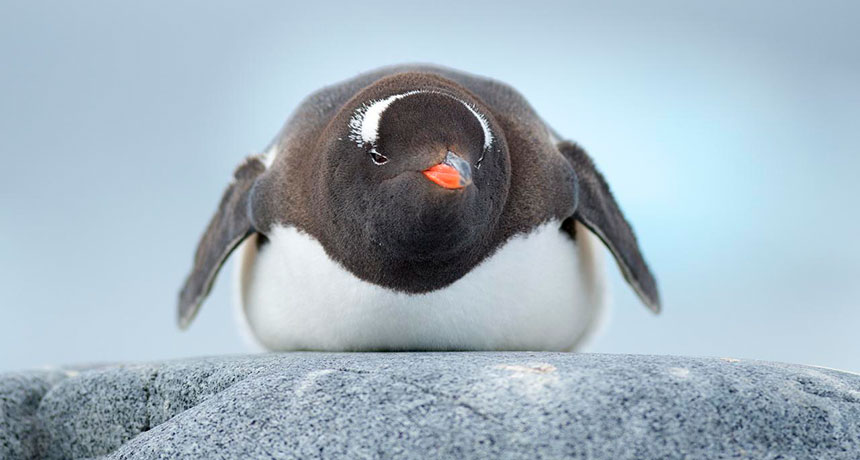Why some penguin feathers never freeze
These birds could inspire new ways to keep ice off of airplane wings

Gentoo penguins live in Antarctica. New research reveals that oil and tiny pores prevent water from freezing on the feathers of these birds.
CHRISTOPHER MICHEL/FLICKR (CC BY 2.0)
By Andrew Grant
Penguins in Antarctica survive in some rough conditions. Temperatures can reach -40° Celsius (-40° Fahrenheit). Winds can blow as fast as 40 meters per second (89 miles per hour). A drenched penguin waddling in such bone-chilling air would seem like a recipe for frozen feathers. Yet the birds don’t become popsicles. That’s because tiny grooves and an oily sheath on the feathers prevent some penguins from freezing, a new study finds.
Pirouz Kavehpour is a mechanical engineer at the University of California in Los Angeles. He and his colleagues studied feathers from gentoo penguins, an Antarctic species, under a scanning electron microscope. The jagged surface of the feathers was full of nano-sized pores. This subtle roughness forces water droplets to slide off rather than stay and freeze. The penguins also release preen oil from a gland near the base of the tail. A bird will use its beak to spread the oil over its feathers. That oil works as a water-repellent.
The Magellanic penguin lives in South America, in warmer climates than the gentoo. It has no pores on its feathers, the researchers found. And it secretes a less-repellant oil. Kavehpour reported his team’s new findings November 22 at the American Physical Society Division of Fluid Dynamics meeting in Boston, Mass.
Ice build-up on penguin wings may not be a big deal for most people. But icing on the wings of an airplane can bring down a craft. So Kavehpour hopes to exploit the birds’ deicing ways to design airplane wings that won’t ice up.
Power Words
(for more about Power Words, click here)
Antarctica A continent mostly covered in ice, which sits in the southernmost part of the world.
gland A cell, a group of cells or an organ that produces and discharges a substance (or “secretion”) for use elsewhere in the body or in a body cavity, or for elimination from the body.
mechanical Having to do with the devices that move, including tools, engines and other machines (even, potentially, living machines); or something caused by the physical movement of another thing (such as a “mechanical” itch).
mechanical engineer Someone who uses physics and materials science to design, develop, build and test mechanical devices, including tools, engines and other machines.
nano A prefix indicating a billionth. In the metric system of measurements, it’s often used as an abbreviation to refer to objects that are a billionth of a meter long or in diameter.
penguin flightless black-and-white bird native to the far Southern Hemisphere, especially Antarctica and its nearby islands.
pore A tiny hole in a surface. On the skin, substances such as oil, water and sweat pass through these openings.
preen To make oneself look more attractive, such as by combing one’s hair or straightening the wrinkles out of one’s clothes. (in biology) A verb for the way birds straighten and clean their feathers.
scanning electron microscope (SEM) A scientific instrument in which the surface of a specimen is scanned by a beam of electrons that are reflected to form an image.
subtle Some feature that may be important, but can be hard to see or describe. For instance, the first cellular changes that signal the start of a cancer may be visible but subtle — small and hard to distinguish from nearby healthy tissues.







